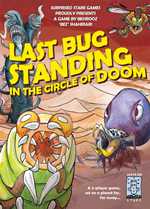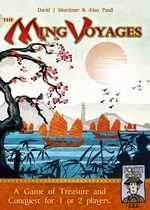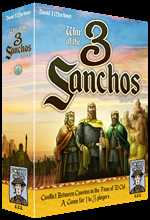
Last Bug Standing In The Circle Of Doom Board Game
In Last Bug Standing in the Circle of Doom, which takes place on a futuristic arena on a planet far, far away, the navigator directs the driver of the crew's vehicle through an alien landscape, while the gunner shoots at Bug-Eyed Monsters (BEMs). If you plot the right course, make the right moves, and pick the right shots, you will have the last bug standing!

The March Of Progress Card Game
Your goal in The March of Progress is to control countries through the playing of action cards so that you generate victory points (VPs) during scoring. Whoever has the most VPs at the end of the game wins.
In the game, each side has a hand of eight action cards, ranging from Move to Attack to Recruit. Each player simultaneously chooses one card to play each turn, then reveals and carries out the action. Cards stay discarded until a player plays their score card after which they regain all played cards.
The March of Progress includes an introductory scenario based on The Thirty Years War to set out the core rules of the game. The game includes four additional historical scenarios: The Age of Marlborough, Vive l'Empereur, World War 1 in the West, and World War 2 in the West. Each scenario changes the set-up and tweaks the rules to give a flavor of strategy in different time periods. The scenarios create a varied and challenging two-player game.

The Ming Voyages Card Game
"The Ming Voyages" are the seven journeys made by the Chinese treasure fleet of oceanic junks between 1405 and 1433. The Yongle Emperor constructed the fleet during a period of outward-looking expansion of Chinese influence overseas, and its commander was Admiral Zheng He. The maritime power of the Ming Empire was used for political purposes, not just for trade. The immense fleet was technologically far in advance of European counterparts until at least the 18th century. While it is purported by some that the fleet circumnavigated the world and discovered all its continents save Europe, the voyages certainly reached Calicut in India and Hormuz in the Persian Gulf, while making landfalls in the Arabian Peninsula and East Africa - but on the landward side of the Empire, border troubles were always brewing.
In The Ming Voyages, one player will be the Ming Emperor who is trying to complete all seven treasure voyages, in addition to protecting the Chinese borderlands from invading barbarians. The other player controls the three disparate barbarian factions who are trying to settle on the borderlands with China. Battles can occur in these borderlands, with players use their three dice to roll for triples, doubles, and singles that are better than their opponent's rolls. Reserved cards can be used for re-rolls.
The game uses multi-function cards (as in The Cousins' War) to provide actions for players to reinforce their armies and attack the enemy and for the Emperor to complete voyages. Play of a card may provide an out-of-turn action for the opponent, so players must be careful of timing. Only the Emperor draws new cards. Players swap hands at the end of each turn, so the Emperor always knows what the Barbarian Overlord holds, and each player tries to exploit the out-of-turn actions.

War Of The Three Sanchos Board Game
In War of the 3 Sanchos 1065-67, the fourth game in the Pocket Campaigns series, you are one of three King Sanchos, fighting for control of castles and towers across Castilla, Navarra, and Arag¢n. The game is designed for 1-3 players.
All three of the King Sanchos, including any non-player Sanchos, are competing to win by fortifying the castles and towers illustrated on the board (one in each region). Players gain victory points for each castle or tower fortified with their pieces: 3 points for a home castle (2 points in the solo game), 2 points for a neutral castle, and 1 point for a tower. If at any time during the game a Sancho has 10 or more victory points, they win a major victory. If no player achieves this during the game, the Sancho with the most victory points after the last card is played wins a minor victory.
The game is played in rounds. Each player has a turn during each round. At the start of the round, the commander for the round plays a card from their hand. This card indicates the number of command points (CPs) from 1 to 3 that the commander uses during the round, and it also describes the actions that each other player must take on their turn, if possible. The game ends either at any point when a Sancho has 10 or more victory points, or after the final card from all players' hands has been resolved.






